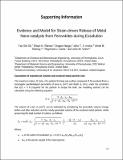Evidence and model for strain-driven release of metal nano-catalysts from perovskites during exsolution
Abstract
The evolution of the surface morphology during exsolution of Ni from the perovskite, La0.4Sr0.4Ti0.97Ni0.03O3-δ, under reducing conditions was determined using atomic force microscopy (AFM). The exsolution process was found to initially induce the formation of a 20-30 nm deep pit on the oxide surface followed by the emergence of a Ni particle at the bottom of the pit. Continued emergence of the particle results in it nearly filling the pit producing a unique structure in which the Ni particle is socketed into the oxide surface. We also show that this morphological evolution can be explained using a simple energy-based model that accounts for the interplay between the surface free energy and the strain energy induced by the included metal nucleate. The unique socketed structure results in strong anchorage between the exsolved particles and the oxide host lattice which imparts both high thermal stability and unique catalytic activity.
Citation
Oh , T S , Rahani , E , Neagu , D , Irvine , J T S , Shenoy , V , Gorte , R & Vohs , J 2015 , ' Evidence and model for strain-driven release of metal nano-catalysts from perovskites during exsolution ' , Journal of Physical Chemistry Letters , vol. 6 , no. 24 , pp. 5106–5110 . https://doi.org/10.1021/acs.jpclett.5b02292
Publication
Journal of Physical Chemistry Letters
Status
Peer reviewed
ISSN
1948-7185Type
Journal item
Description
The authors thank the U.S. National Science Foundation (NSF) and the European Engineering and Physical Sciences Research Council for funding through the Materials World Network Program (grant nos. DMR-1210388 and EP/J018414/1). The authors also thank the NSF MRSEC Center at the University of Pennsylvania (DMR11-20901) for partial support of this work. VBS also acknowledges NSF support through grant CMMI-1363203. Date of Acceptance 07/12/2015Collections
Items in the St Andrews Research Repository are protected by copyright, with all rights reserved, unless otherwise indicated.

